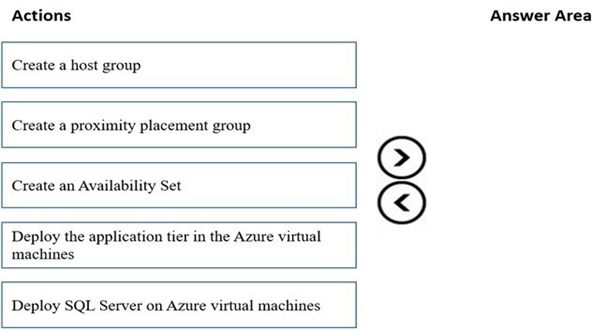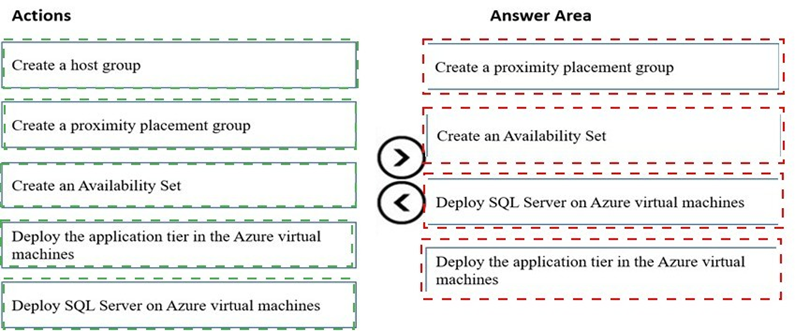Topic 2: Misc. Questions
You have an Azure subscription that contains an Azure Monitor for SAP solutions resource and a virtual machine named VM1. VM1 runs SUSE Enterprise Linux (SLES) and hosts an SAP NetWeaver application server.
You need to monitor the CPU, memory, and network usage of VM1 by using the Azure Monitor for SAP solutions resource.
What should you do first?
A.
From the Azure portal, add the Azure Monitor for SAP solutions OS (Linux) provider.
B.
From the Azure portal, add the Azure Monitor for SAP solutions NetWeaver provider.
C.
On VM1, install the Telegraf agent.
D.
On VM1, install the Prometheus node exporter.
On VM1, install the Telegraf agent.
You are designing an SAP HANA deployment. You estimate that the database will be 1.8 TB in three years. You need to ensure that the deployment supports 60,000 IOPS. The solution must minimize costs and provide the lowest latency possible.
Which type of disk should you use?
A.
Standard HDD
B.
Premium SSD
C.
Ultra disk
D.
Standard SSD
Ultra disk
You have an Azure virtual machine that runs SUSE Linux Enterprise Server (SlES). The virtual machine hosts a highly available deployment of SAP HANA. You need to validate whether Accelerated Networking is operational for the virtual machine. What should you use?
A.
fio
B.
iometer
C.
netsh
D.
ethtool
ethtool
Explanation:
Check for activity on the VF (virtual function) with the ethtool -S eth0 | grep vf_ command. If you receive output similar to the following sample output, accelerated networking is enabled and working.
vf_rx_packets: 992956
vf_rx_bytes: 2749784180
vf_tx_packets: 2656684
vf_tx_bytes: 1099443970
vf_tx_dropped: 0
Accelerated Networking is now enabled for your VM.
You have a highly available deployment of SAP NetWeaver on Azure virtual machines. The database tier is hosted on two virtual machines that run Windows Server 2019 and have Microsoft SQL Server 2017 installed. The NetWeaver, application, and database tiers each reside on a separate subnet within the same virtual network.
You run ABAPMeter against the deployment and discover that the average value of Act DB is 2 ms.
You need to lower the Acc DB value. What should you do?
A.
Increase the tempdb size on the SQL Server virtual machines.
B.
Move the application virtual machines to the same subnet as the SQL Server virtual machines.
C.
Configure the SQL Server database to use asynchronous replication.
D.
Redeploy the NetWeaver. application, and SQL Server virtual machines to the same proximity placement group.
Redeploy the NetWeaver. application, and SQL Server virtual machines to the same proximity placement group.
Note: This question is part of a series of questions that present the same scenario. Each question in the series contains a unique solution that might meet the stated goals. Some question sets might have more than one correct solution, while others might not have a correct solution.
After you answer a question in this section, you will NOT be able to return to it. As a result, these questions will not appear in the review screen.
You deploy SAP HANA on Azure (Large Instances). You need to back up the SAP HANA database to Azure.
Solution: Back up directly to disk, copy the backups to an Azure virtual machine, and then copy the backup to an Azure Storage account
A.
Yes
B.
No
No
Explanation:
Instead you should create a Recovery Services vault and a backup policy.
You have an SAP production landscape that uses SAP HANA databases on Azure. The HANA database server is a Standard.M32ms Azure virtual machine that has 864 GB of RAM. The HANA database is 400 GB. You expect the database to grow by 40 percent during the next 12 months. You resize the HANA database server virtual machine to Standard_m64ms and ,024 GB of RAM. You need to recommend additional changes to minimize performance degradation caused by database growth What should you recommend for the HANA database server?
A.
Increase the number of vCPUs.
B.
Configure additional disks
C.
Add a secondary network interface.
D.
Add a scale out node.
Increase the number of vCPUs.
You have an SAP environment on Azure. your on-promises network connects to Azure by using a site-to-site VPN connection.
6u need to alert technical support if the network bandwidth usage between the on-premises network and Azure exceeds 900 Mbps 10 minutes. What should you use?
A.
Azure Network Watcher
B.
NIPING
C.
Azure Monitor
D.
Azure Enhanced Monitoring for SAP
Azure Monitor
Explanation:
You set up alerts on Azure VPN Gateway metrics. Azure Monitor provides the ability to set up alerts for Azure resources. You can set up alerts for virtual network gateways of the "VPN" type.
Metric: AverageBandwidth: Average combined bandwidth utilization of all site-to-site connections on the gateway.
https://docs.microsoft.com/bs-latn-ba/azure/vpn-gateway/vpn-gateway-howto-setup-alerts- virtual-network-gateway-metric
You are deploying an SAP environment on Azure that will use an SAP HANA database server. You provision an Azure virtual machine for SAP HANA by using the M64s virtual machine SKU. You need to set the swap space by using the Microsoft Azure Linux Agent (waagent) configuration file. Which two settings should you configure? Each correct answer presents part of the solution. NOTE: Each correct selection is worth one point.
A.
ResourceDisk.EnableSwapEncryption=n
B.
AutoUpdate.Enabled=n
C.
ResourceDisk.SwapSizeMB=229376
D.
ResourceDisk.EnableSwap=y
ResourceDisk.SwapSizeMB=229376
ResourceDisk.EnableSwap=y
Explanation:
To create a swap file in the directory that's defined by the ResourceDisk.MountPoint parameter, you can update the /etc/waagent.conf file by setting the following three parameters:
ResourceDisk.Format=y ResourceDisk.EnableSwap=y ResourceDisk.SwapSizeMB=xx
References:
https://support.microsoft.com/en-us/help/4010058/how-to-add-a-swap-file-in-linux-azure- virtual-machines
You have an SAP landscape on Azure. You deploy an SAP Web Dispatcher named web1. You need to confirm that web1 can support 1,500 users. What should you use?
A.
Apache JMeter
B.
lometer
C.
ABAPMeter
D.
FIO
Apache JMeter
You are planning a deployment of SAP on Azure that will use SAP HANA. You need to ensure that the SAP application servers are in the same datacenter as the HANA nodes. What should you use?
A.
a resource group
B.
a virtual machine scale set
C.
an application group
D.
a proximity placement group
a proximity placement group
You deploy an SAP landscape on Azure. You plan to use an Azure Automation account to stop the SAP virtual machines outside of business hours. You need to ensure that you can use Azure Automation runbook a for the virtual machines. What does the Azure Automation account require?
A.
an Azure Storage account
B.
an Azure App Service WebJob
C.
a Recovery Services vault
D.
a Run As account
an Azure App Service WebJob
You have an Azure subscription.You plan to deploy a SAP NetWeaver landscape that will use SQL Server on Azure virtual machines. The solution must meet the following requirements:
The SAP application and database tiers must reside in the same Azure zone. The application tier in the Azure virtual machines must belong to the same Availability Set.
Which four actions should you perform in sequence? To answer, move the appropriate actions from the list of actions to the answer area and arrange them in the correct order.
NOTE: More than one order of answer choices is correct. You will receive credit for any of the correct orders you select.

Answer:
Explanation:

Step 1: Create a proximity placement group
A proximity placement group is a logical grouping of Azure resources within the same Azure data center in order to reduce latency.
Step 2: Create an Availability Set
Create an availability set that references the Azure proximity group.
By adding the availability sets to proximity placement groups, the network latencies are considerably reduced, thereby improving the overall performance.
Step 3: Deploy SQL Server on Azure Virtual machines
Step 4: Deploy the application tier in the Azure virtual machines
Deploy the application layer VMs by referencing the availability set and the proximity placement group.
| Page 7 out of 19 Pages |
| Previous |